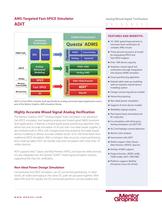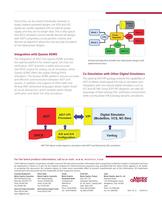
Catalog excerpts

AMS-Targeted Fast-SPICE Simulator Analog/Mixed-Signal Verification ADiT D A T A S H E E T FEATURES AND BENEFITS: ■ 10–100X speed improvement in transistor-level verification of complex AMS circuits ■ Three percent accuracy of results by integrating SPICE and Fast-SPICE engines ■ Over 10M device capacity ■ Seamless mixed-signal SoC verification through integration into Questa ADMS simulator ■ Smart partitioning algorithm ■ Default table-look up modeling with an equation-based device modeling option ■ Charge-conserving device models ■ Hierarchical parsing ADiT is a Fast-SPICE simulator built specifically for analog and mixed-signal applications and is part of the Mentor Graphics AMS simulation family. Highly Accurate Mixed Signal Analog Verification The Mentor Graphics ADiT™ (Analog Digital Turbo Simulator) is an advanced Fast-SPICE simulation tool targeting analog and mixed-signal (AMS) transistorlevel applications. It features a mixed-signal aware partitioning algorithm that allows fast and accurate simulation of circuits with non-ideal power supplies. It also embeds built-in SPICE with chargeconserving analytical and table-based device modeling to deliver accurate, reliable results 10 to 100 times faster than traditional SPICE simulation. With a compact data structure, smart partitioning, and a look-up table, ADiT can handle chip-level simulation with more than 10 million devices. ADiT supports Eldo® Classic and Eldo Premier, HSPICE, and Spectre netlist formats. It is also integrated into the Questa® ADMS™ mixed-signal simulation solution, supporting full-chip SoC verification. Non-Ideal Power Design Simulation Conventional Fast-SPICE simulators use DC-connected partitioning. In other words, all nodes belonging to the same DC path are grouped together. With ideal VDD and VSS signals, the DC-connected partitions can be isolated, and w w w. m e nto r. co m ■ Non-ideal power simulation ■ Support of most device models ■ Reliability (aging) analysis ■ Post-layout back annotated and RC reduction ■ Co-simulation with third-party Verilog simulators via ADiT-VPI ■ Hi-Z and leakage current detection ■ Monte Carlo analysis ■ Save/restart with ADiT ■ Netlist support: Eldo Classic, Eldo Premier, HSPICE, Spectre ■ Verilog-A/AMS support ■ Output formats: JWDB (.wdb), FSDB (.fsdb), ADiT (.TR0/.TB0) ■ Platform support: RedHat Enterprise Linux (32, 64 bit)
Open the catalog to page 1
hence they can be solved individually. However, in today's battery-powered designs, the VDD and VSS signals are usually regulated with an internal power supply, and they are no longer ideal. This is why typical Fast-SPICE simulators cannot handle derived rail designs well. ADiT's proprietary circuit partition scheme and derived rail algorithm allows fast and accurate simulation of non-ideal power designs. Integration with Questa ADMS The integration of ADiT into Questa ADMS provides the optimal platform for mixed-signal, full-chip SoC verification. ADiT provides a stable and accurate...
Open the catalog to page 2All SIEMENS EDA catalogs and technical brochures
-
Calibre nmDRC
4 Pages
Archived catalogs
-
Tessent Connect
3 Pages
-
Calibre LFD
3 Pages
-
Vista Virtual Prototyping
4 Pages
-
Vista Architect
4 Pages
-
Tessent IJTAG
2 Pages
-
Calibre® MPCpro
2 Pages
-
LeonardoSpectrum
4 Pages
-
Oasys-RTL
3 Pages
-
Olympus-SoC
5 Pages
-
ICanalyst
4 Pages
-
Calibre RVE
3 Pages
-
Calibre nmLVS
3 Pages
-
Calibre LFD
3 Pages
-
Tanner L-Edit IC Layout
4 Pages
-
Tanner Designer
2 Pages
-
Tanner Waveform Viewer
2 Pages
-
Tanner T-Spice Simulation
2 Pages
-
ReqTracer
2 Pages
-
LeonardoSpectrum™
4 Pages
-
HDL Designer
2 Pages
-
Nucleus RTOS
2 Pages
-
Calibre ® MPCpro
2 Pages
-
Calibre OPC and PSM
6 Pages
-
Multicore Framework
2 Pages
-
Volcano VSTAR Ethernet
2 Pages
-
Volcano VSTAR AUTOSAR
2 Pages
-
CAT/TransCable
2 Pages
-
ReadyStart?
2 Pages
-
Inflexion UI
2 Pages
-
TransDesign
6 Pages
-
TransCable
2 Pages
-
TranSACT
2 Pages
-
TransOVM
2 Pages
-
TransBridge
2 Pages
-
Calibre xACT 3D
2 Pages
-
Volcano? VSA
2 Pages
-
Calibre xRC
3 Pages
-
Calibre xRC-CB
2 Pages
-
ces-ds
2 Pages
-
VolcanoBootloader
2 Pages
-
flovent
12 Pages
-
flotherm
8 Pages
-
floefd
12 Pages
-
Calibre DESIGNrev
2 Pages
-
Calibre xL
2 Pages
-
Calibre nmDRC
4 Pages
-
Calibre RealTime
2 Pages
-
Questa ADMS
7 Pages
-
iSolve DigIQ Interface
2 Pages
-
Questa® Codelink Turbo
3 Pages
-
RC250
2 Pages
-
RC340
2 Pages
-
Atmel SAM9263
2 Pages
-
Sourcery Analyzer
2 Pages
-
Capital Migration Services
2 Pages
-
Capital Harness MPM
2 Pages
-
Vista
4 Pages
-
Capital ModularXC
2 Pages
-
Capital HarnessXC
2 Pages
-
Capital Integrator
2 Pages
-
Capital Logic
2 Pages
-
Volcano Bootloader
2 Pages
-
Calibre® OPCverify™
2 Pages
-
Nucleus
2 Pages
-
Mentor Embedded Linux
10 Pages
-
PADS AutoRouter
4 Pages
-
Board Station XE (BSXE
9 Pages
-
Board Architect
2 Pages
-
PADS Suites
3 Pages
-
AccuSim II
2 Pages
-
AccuParts™
1 Pages
-
FloVENT
12 Pages
-
FloTHERM PCB
2 Pages
-
FloTHERM® IC
2 Pages
-
Calibre OPCverify
2 Pages
-
Olympus-SoC
2 Pages
-
Catapult C Synthesis
4 Pages
-
NUCLEUS RTOS SOLUTIONS
2 Pages
-
EDGE Developer Suite
2 Pages
-
MAJIC JTAG Probe
3 Pages
-
Mentor Embedded Inflexion UI
2 Pages
-
CHS
4 Pages
-
VeSys
2 Pages
-
TransLayout™
2 Pages
-
PCB Systems Board Station XE
4 Pages
-
Mechanical Analysis FloEFD
7 Pages
-
Calibre nmOPC
2 Pages









































































































